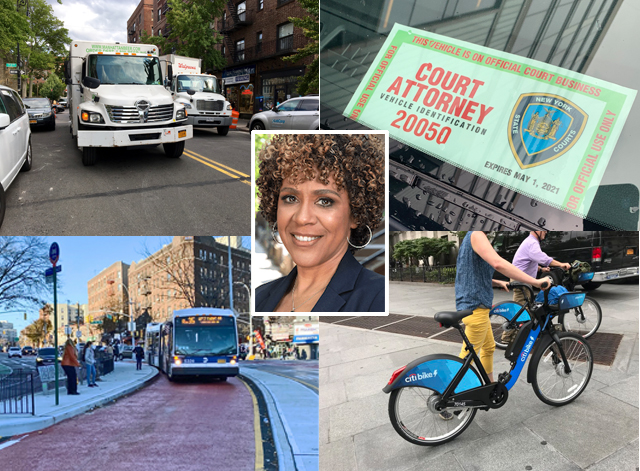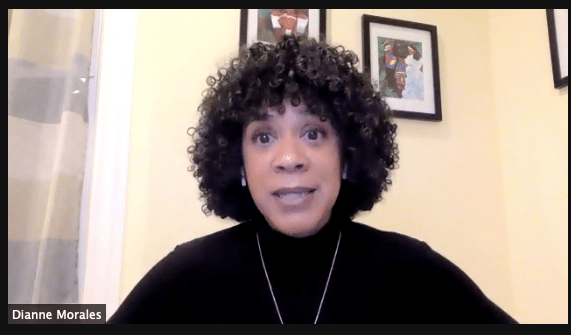DECISION 2021: Dianne Morales’s Transportation Plan is a Bold, Intersectional Statement
12:01 AM EST on March 11, 2021

This is the fourth in a series of deep dives into the mayoral candidates’ positions on transportation issues affecting the city. So far, we’ve looked at plans by Shaun Donovan, Scott Stringer and Kathryn Garcia — and analyzed them in, as you can see, lengthy, detailed form. But too many candidates are silent on this key lifestyle, climate and equity issue (the websites of Maya Wiley and Ray McGuire, for example, don’t specifically address transportation). We encourage all candidates to participate in our coverage by emailing Streetsblog Editor Gersh Kuntzman at gersh@streetsblog.org.
Scott Stringer says he wants to be the Bus Mayor — but Dianne Morales not only wants to be the omnibus ombudsman, but also the Expanded Citi Bike Executive, the Bus Rapid Transit Technocrat, the Daylighting Director and the Sidewalk Czarina, too.
And she wants to do it all by reimagining how the city engages with communities that often balk at change so that they, well, stop doing that.

It's all part of the "Public Infrastructure Investment" plan that was released this week by Morales — the latest blueprint from a former public school teacher and LGBTQ non-profit director who has found a following among progressives who not only want change, but change in how we make change so that ideas like policing, housing, transportation, public space and the environment aren't silos.
As such, the proposal is not merely a "transportation" plan, but a broader proposal that includes the widest definition of public space needs, such as broadband wireless, a public takeover of utilities, creating more parks, ending "hostile architecture" and changing the way land is even developed.
But the core of the white paper (read it all here) is a call to arms: "It’s time to reclaim our space!" Our space? Here's what Morales will champion:
- daylighting all intersections
- expanding busways and express bus lanes, especially in low-income neighborhoods suffering from what she calls "transit apartheid"
- implementing Bus Rapid Transit along major corridors
- making Citi Bike a public utility and pricing it at $0 for all city residents
- requiring more pedal assist electric Citi Bikes, especially in transit deserts that, she says, "have been ignored under the private-public partnership"
- widening and protecting sidewalks
- narrowing roadways to calm traffic
- expanding metered parking and loading zones
- creating incentives for off-hour freight deliveries
- and, yes, ending placard abuse.
On top of that, Morales is also the latest candidate to fully embrace the Transportation Alternatives "NYC 25x25" plan, which aims to claw back 25 percent of our streetscape from car travel and storage (previously, Scott Stringer, Carlos Menchaca, Maya Wiley, Shaun Donovan and Kathryn Garcia have endorsed the plan to varying degrees, as Streetsblog reported).
Of course, many mayoral candidates have put out policy positions that emphasize changes to the streetscape to make all road users — from the most-vulnerable pedestrians all the way to truck drivers — safer, and to make our city more "livable." But Morales's document is more explicit in seeing streets themselves as public space and "not as conduits for commercialization and combustion-powered vehicles."
She says she was inspired by what she and her Bedford-Stuyvesant neighbors experienced during the COVID-19 crisis.
"We are at a really interesting time to have this conversion," she said in an interview with Streetsblog. "The open streets program opened up the imagination of so many New Yorkers. People had the experience to walk and be among the community. And it has primed New Yorkers to want to reclaim our spaces. Every little pocket where [open streets] were working felt otherworldly — people really embraced it. There is an opening here to take it to the next level. The city was designed to prioritize cars and not people, and now is the time to put people first."
OK, so how? Mayoral candidates who have never sat through a community board meeting or a four-hour "visioning" session with the Department of Transportation often reveal through their comments that they literally have never experienced the process by which great ideas get sidetracked by the loudest (usually car-owning) voices in the room or, on the flip-side, get watered down before they even get off a DOT drawing board because the agency hasn't done enough to engage on-the-ground supporters to take on recalcitrant community boards.
Morales's policy statement was vague on how she would change that — it includes puffery such as "a Morales administration will recognize the human right to participate in decisions that impact our communities and allocate resources to fulfill the will of the people" — so Streetsblog asked her to cut through that platitude and say what she really means. It turns out that it doesn't mean she'll just defer to the community board.
"This comes up a lot — how do must expand beyond the existing structures for community engagement," she said. "For me, we need to look at the existing structures such as community boards and what the pathways for engagement are in them — and if they are the right or wrong structures. In any event, we need to cast a wider net to engage other groups. The community boards are the default engagement structure, but I think there is a need to engage other communities and representatives and advocates that may or may not be on the community boards, which are often not fully representative of the communities they're supposed to represent."
Here's what she means: Say, for example, the DOT says it wants to remove 200 parking spaces to create a car-free busway. The community board would have the predictable negative response, even in a neighborhood where car owners are the minority. Morales said the trick is not to ignore the community board, but to do far more community organizing in advance so that the DOT hears from advocates — and the local advocates lead from the grassroots. We bounced the parking question off Morales and she exhibited a true understanding of the problem.
"I live in Bed-Stuy and that's the case of the community board here — they would have that reaction," she said. "So that shows there's a deeper engagement and education process that needs to happen so they see the connection between the cars and the pollution and the cars and the crashes — and who is being impacted by that. Bringing the community along in the process requires a lot of pounding the pavement and education. and encouragement and engagment from the ground up. There are proponents on the ground who city government must engage so that we build a movement and get to critical mass.
"We know from just the science that the cars are not good and that we need to move away from them," she said. "We need to reduce overall the number of parking spaces, for example. So we need to organize so we get the buy-in."
Still, Morales has gotten some heat from street-safety advocates for her consistent comments about people who "need" their cars. For example, in response to a Streetsblog questionnaire last year, Morales said she opposed an outright ban on private car ownership in Manhattan, arguing that "areas of the city with [more] working and middle class tend to have more drivers" and saying she aims to act "without further burdening poor, working and middle class families and communities."
We asked Morales if that meant she would not advocate for car-reduction policies under the misguided notion that poorer people are more likely to own cars than the wealthy (they aren't). She clarified that she would advocate for such policies, but only after organizing so that affected communities understand how they would benefit.
"If we are increasing access to transportation, we will hear fewer people advocating that they 'need' their cars," she said. "I'm always concerned about people who use their cars to actually make their living, like drivers or delivery workers. but in general, we need to address the car culture. I get that some people feel like they have to use their car, but that can be addressed with better transit."
The big problem is what Morales calls "transit apartheid" — the system by which true investments are made in wealthy neighborhoods.
"Transit apartheid is deliberate," she said. "When you look at the Second Avenue subway or the extension of the 7 train [to Hudson Yards], that was by design to help wealthy neighborhoods. But we have not extended the subway in other neighborhoods. Black and Brown communities have less access to transit."
To solve that initially, Morales said she would dramatically expand bus service (though some of that would require Albany buy-in). "We need more express bus service and we need busways, but from the edges of the city first. We have to bring the margins to the center. And we need to explore the possibility of making buses free."
She is also a big supporter of moving the NYPD's Collision Investigation Squad into the DOT — a proposal that has created tension between the two wings of City Hall.
"When a crash happens, there isn't an examination of the pattern or the way it was built that contributed to the crash," she said. "So let's investigate that rather than just criminalizing the driver. I'm for decarceration in general, so this is in alignment with that, and furthers the goal of saving people's lives. I grew up near DeKalb and Bedford avenues. And that corner was the site of many car accidents [sic] to the point where the bodega put up barriers. But why wasn't the city looking at that?"
Gersh Kuntzman is editor in chief of Streetsblog NYC and Streetsblog USA. He also writes the Cycle of Rage column, which is archived here.
Stay in touch
Sign up for our free newsletter
More from Streetsblog New York City
Report: Road Violence Hits Record in First Quarter of 2024
Sixty people died in the first three months of the year, 50 percent more than the first quarter of 2018, which was the safest opening three months of any Vision Zero year.
Street Sweepers Could Nab Illegal Parking Under State Bill
Smile for the street-sweeper!
Thursday’s Headlines: The Way of Water Edition
The "Blue Highways" campaign wants the mayor to convert a downtown heliport into a freight delivery hub. Plus more news.
Gotcha-Heimer! Anti-Congestion Pricing Jersey Rep. With a City Speeding Ticket Drove to Manhattan on Wednesday
New Jersey's most vociferous opponent of congestion pricing parked illegally and once got a speeding ticket.




